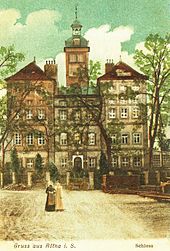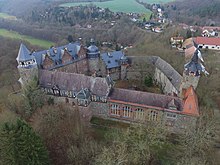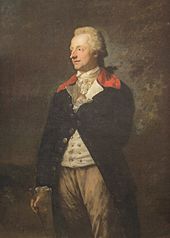Frisians (noble family)
Friesen is the name of a noble family that first appeared in documents in Franconia at the end of the 14th century . The family, of which individual branches still exist today, later acquired property and reputation , especially in Thuringia and Saxony . One branch of the family has been called Freiherren von Friesen called von Leyßer since the 19th century , another branch is called Freiherren von Friesen-Miltitz .
history
origin
After Kneschke the family originally came under the name Friess and friezes from Switzerland , where they should have been known since the 13th century. Accordingly, they were a wealthy aristocratic family around Basel , from which several members left Switzerland at the end of the 13th and beginning of the 14th centuries and settled in Upper Saxony .
The family with Stephan von Frisen is first mentioned in a document in a document issued in Nuremberg in 1388. Stephan appears there as a servant of the burgrave of Nuremberg , Friedrich von Hohenzollern . The lords of Friesen were probably related to the von Friesen family, who came from the Landgraviate of Upper Alsace and had a similar coat of arms .
The uninterrupted line of the family begins with Karl von Friesen . In 1488, Karl received the Kauern estate near Ronneburg as a fief from the Elector of Saxony, Frederick the Wise .
Spread and personalities

Already in 1409 Heinrich von Friesen received the Gut Köttewitz (today part of Dohna ) as a fief from Friedrich the Arguable , the Margrave of Meißen . The 1488 acquired Good Crouch remained three generations of the family, was sold until 1592, when Carl von Friesen from those of Pflugk the Roetha Castle acquired, together with the associated city Rötha , the outworks to Podschütz and aspen grove and the villages theca ( today in Rötha), Geschwitz and Großpötzschau . He became the progenitor of several lines, two of which have survived into modern times.
His grandson Heinrich von Friesen († 1689) brought the imperial baron status to the family and his grandson Julius Heinrich Freiherr von Friesen was raised to the imperial count . Julius Heinrich died in 1706 as an imperial field marshal . During the War of the Spanish Succession , he successfully defended the Landau Fortress in 1703 and enabled the Drusenheim Fortress to be captured in 1705 . He married a Marquise de Montbrun.
The marriage arose from Heinrich Friedrich Graf von Friesen (1681–1739), who was the royal Polish and Electoral Saxon secret cabinet minister , lieutenant general and governor of Dresden . In 1725 he married Augusta Constantia Countess von Cosel , a daughter of Constantia von Cosel and the Saxon Elector Augustus the Strong . Through the marriage he received the rulership of Königsbrück in Upper Lusatia . Of his sons, August Heinrich Graf von Friesen (* 1727) became the landlord of Königsbrück and royal French maréchal de camp . With his death on March 29, 1755 in Paris , the count's line expired. Königsbrück Castle remained in the possession of the Frisians until 1773.

Carl Freiherr von Friesen , electoral privy councilor and consistorial president, Herr auf Rötha and Cotta , rebuilt Cotta Castle in 1662 and the new Rötha Castle, which was devastated in the Thirty Years' War . He also acquired the forest near Borna and called the abbey. His grandson Christian August Freiherr von Friesen (* March 15, 1674; † September 24, 1737) died as a lieutenant general in Electoral Saxony before Belgrade. He was able to reunite the Cotta estate, inherited from his grandfather, with the Rötha estate. He received Rötha in 1717 after his uncle, the electoral secret chancellor Otto Heinrich Freiherr von Friesen (1654-1717), died without heirs. As early as 1703 he bought the Rammelburg office in the county of Mansfeld from his brother-in-law Arndt Adrian von Stammer , thereby giving his uncle Otto Heinrich and his aunt Henriette von Friesen, married Baroness von Gersdorff, the occasion to found the free-aristocratic Magdalenenstift in Altenburg , which also houses the family several colleges and educators had to fill.
Carl August and Johann Friedrich Ernst, sons of Christian August, shared the Cotta and Rötha estates again, but jointly kept Rammelburg Castle and donated the two main lines of the family.
Karl August Freiherr von Friesen, the older son, Herr auf Cotta and co-owner of the Rammelburg office, became a lieutenant colonel in Electoral Saxony . He married Caroline Wilhelmine von Wangenheim . His grandsons Heinrich Adolf Freiherr von Friesen († 1844) and Georg Maximilian Freiherr von Friesen († 1845) divided the main line into a younger and an older branch. Richard Freiherr von Friesen (1808-1884), a son of Heinrich Adolf, who became State Minister and Minister of Finance , came from the older branch . Of his three brothers, Julius Freiherr von Friesen (* 1810) was appointed royal Saxon higher appellate judge and Edwin Freiherr von Friesen (* 1811) royal Saxon major .
The younger or Rötha main line was founded by Johann Friedrich Ernst Freiherr von Friesen († 1768), Lord of Rötha and co-owner of Rammelburg. From his marriage to Christine Jacobine Countess von Werthern came Johann Georg Friedrich Freiherr von Friesen (1757–1824), lord of Rötha and Bronholz, who died as a royal Saxon upper chamberlain and privy councilor. He bought the second half of the Rammelburg office from his cousin and the Trachenau manor from the von Schönfeld family . Johann Georg Friedrich was married twice, first with Johanna Fredericke von Krosigk († 1781) and the second with Julie Caroline Countess von der Schulenburg from the Wolfsburg family († 1803). From the second marriage came Friedrich Freiherr von Friesen (* 1796), owner of Rötha with Podschütz, Geschwitz, Großpötzschau, Espenheim and the forest Abbey Borna as well as the estate Trachenau with Treppendorf. He became a royal Saxon chamberlain, secret finance councilor and canon of Naumburg . Of his brothers, Friedrich Freiherr von Friesen (1796–1871) became a member and president of the 1st Chamber of the Saxon State Parliament and Ernst Freiherr von Friesen (1800–1869) owner of the office of Rammelburg with Hayder and Hilkenschwenda, royal Prussian chamberlain and district administrator.
Numerous members of the family received an entry in the royal Saxon nobility book , for example on October 5, 1903 the descendants of the winery owner Oskar Freiherr von Friesen, who died on June 17, 1903, under number 20 and Otto Heinrich Freiherr von Friesen, Fideikommissherr on Rötha, royal -sächsischer Chamberlain and major for disposition under number 21, Ernst Freiherr von Friesen, royal-Saxon Maj for disposition under number 22, Karl Freiherr von Friesen-Miltitz, royal-Saxon Maj for disposition under number 22, Karl Freiherr von Friesen -Miltitz, Royal Saxon Major General at the disposition under number 23, Heinrich Freiherr von Friesen, Royal Saxon Chamberlain, Real Privy Councilor and Envoy in Munich, Stuttgart, Karlsruhe and Darmstadt under number 24, Alexander Freiherr von Friesen, Royal Saxon Major general available under number 25, Giesbert Freiherr von Fri esen, Grand Ducal Oldenburg Upper Chamberlain out of service and Royal Prussian Rittmeister out of service under number 26 and Edwin Freiherr von Friesen, royal Saxon lieutenant under number 27.
A family association founded on April 18, 1891 in Dresden held family days at irregular intervals.
In 2009, the family of the Barons von Friesen donated 90 paintings of cultural and historical value to the non-profit association State Palaces, Castles and Gardens of Saxony . The “Heinrich Freiherr von Friesen / Rötha” foundation was established at Nossen Castle , and the collection was incorporated into it.
Status surveys
Heinrich von Friesen the Elder, electoral Saxon Privy Councilor and court chancellor, and his sons Heinrich von Friesen the Younger and Carl von Friesen were elevated to the status of imperial baron in Regensburg on August 18, 1653 . On April 13, 1657, they received electoral Saxon recognition of the baron status.
Heinrich Freiherr von Friesen , Imperial Field Marshal and Commander of the Landau Fortress, was elevated to the rank of imperial count in Vienna on September 25, 1702. An electoral Saxon recognition took place on November 21, 1703.
Name and coat of arms associations
Baron von Friesen called von Leyßer
With the death of the royal Saxon lieutenant general Wilhelm Friedrich August von Leyßer (1771–1842), owner of the Fideikommiss- und Majoratsgut Friedrichsthal near Bad Gottleuba-Berggießhübel , Johannes Freiherr von Friesen was empowered by legacy in 1842 to include the names and coats of arms of those von Leyßer with his to unite ancestral names and coat of arms so that the name of Leyßer does not die out. A royal Saxon confirmation took place on May 19, 1843 in Dresden with the name form Freiherr von Friesen called von Leyßer.
Baron von Friesen-Miltitz
Karl Freiherr von Friesen (1847–1928), Royal Saxon Premier Lieutenant , married Marie Freiin von Miltitz auf Batzdorf . On November 16, 1880, he received a royal Saxon name association with that of Miltitz as Baron von Friesen-Miltitz in Dresden.
coat of arms
| Family coat of arms | |
|
Blazon : “The family coat of arms in silver is split. On the right of the slit half of a six or eight-pointed red star , on the left a red crescent moon opened to the right. On the helmet with red-silver helmet covers, the star half and the crescent moon turned upwards, each set with a natural peacock feather on both horns. "
The family coat of arms appears for the first time on a seal on a document dated April 1, 1425. |
|
| Baron and Count's coat of arms | |
| Blazon : “The imperial baron coat of arms (awarded in 1653) and the imperial counts coat of arms (awarded in 1702) are square and have a heart shield (family coat of arms). 1 and 4 in gold a crowned eagle , 2 and 3 in silver three (1, 2) red roses on green-leaved stems (coat of arms of the von Friesen, who come from Thuringia). The coats of arms have three helmets with black and gold on the right and red and silver on the left. On the right helmet the eagle growing, in the middle the trunk helmet, on the left five (red-silver-red-silver-red) ostrich feathers (trunk helmet of the Thuringians of Friesen). " | |
Known family members
- Alexander von Friesen (1849–1921), Royal Saxon Major General
- Astrid von Friesen (* 1953), German journalist and educator
- August Heinrich von Friesen (1727–1755), French maréchal de camp and grandson of August II of Saxony
- Bernhard von Friesen (1825–1889), administrative officer, manor owner and member of parliament
- Carl von Friesen (1551–1599), manor owner, head chef, court marshal, governor
- Carl von Friesen (1619–1686), baron, privy councilor, president of the senior consistory, church council, senior court judge, manor owner
- Carl von Friesen (1786–1823), Saxon envoy
- Christian August von Friesen (1646–1681), Reichshofrat and provost of Meissen
- Christian August von Friesen (1674–1737), royal Polish and electoral Saxon general
- Ernst von Friesen (1800–1869), Prussian district administrator
- Friedrich von Friesen (1796–1871), German conservative politician, President of the Landtag, Privy Councilor and manor owner
- Heinrich Baron von Friesen (1610–1680), Saxon Privy Council director
- Heinrich von Friesen-Rötha (1831–1910), German majorate leader and member of the Reichstag
- Heinrich Friedrich von Friesen (1681–1739), elective general and diplomat
- Henriette Amalie von Friesen (1668–1732), Countess Reuss zu Obergreiz
- Johann Georg Friedrich von Friesen (1757–1824), Privy Councilor and Supervisor of the Dresden Art Collections and Library
- Juliane von Friesen (* 1950), German business lawyer and politician
- Julius Heinrich von Friesen (1657–1706), Imperial General Feldzeugmeister
- Karl von Friesen-Miltitz (1847–1928), Saxon lieutenant general
- Otto Heinrich von Friesen (1654–1717), Polish Privy Councilor
- Richard von Friesen (1808-1884), Saxon politician
literature
- Karlheinz Blaschke : Frisians, barons of. In: New German Biography (NDB). Volume 5, Duncker & Humblot, Berlin 1961, ISBN 3-428-00186-9 , p. 611 f. ( Digitized version ).
- Heinrich Theodor Flathe : Frisians: von, barons . In: Allgemeine Deutsche Biographie (ADB). Volume 8, Duncker & Humblot, Leipzig 1878, p. 87.
- Ernst Freiherr von Friesen: History of the imperial baron family von Friesen. 2 volumes, Dresden 1899.
- Genealogisches Handbuch des Adels , Adelslexikon Volume III, Volume 61 of the complete series, pp. 390-391, CA Starke Verlag , Limburg (Lahn) 1975 ISSN 0435-2408 .
- Christian Friedrich Jacobi: European genealogical manual. (Descendants of General August von Friesen) p. 178. ( digitized version )
- Ernst Heinrich Kneschke : New general German nobility lexicon . Volume 3, Friedrich Voigt's Buchhandlung, Leipzig 1861, pp. 362–364. ( Digitized version )
- Valentin König ea: Genealogical aristocratic history. Volume 1, Wolfgang Derr, Leipzig 1727, pp. 393-415. (Family tree and pedigrees) ( digitized version )
- August Wilhelm Bernhardt von Uechtritz : Diplomatic news concerning noble families. P. 67. ( digitized version )
- Leopold von Zedlitz-Neukirch : New Prussian Adelslexicon . Volume 2, Gebrüder Reichenbach, Leipzig 1836, p. 197. ( digitized version )
- New genealogical manual. P. 269, digitized version (descendants of General August von Friesen)
Web links
- Entry about imperial barons of Frisians in the central database of estates
- Friezes. In: Johann Heinrich Zedler : Large complete universal lexicon of all sciences and arts . Volume 9, Leipzig 1735, sheet 1084.
Individual evidence
- ↑ a b c d e f g New general German nobility lexicon. Volume 3, pages 362-364.
- ↑ Traugott Maercker, Rudolph von Stillfried (ed.): Monumenta Zollerana. Volume V, p. 222, No. CCXIII.
- ↑ a b c d e f g h i Genealogisches Handbuch des Adels , Adelslexikon Volume III, Volume 61 of the complete series, pp. 390–391.
- ↑ Princely Reussian Archive, Schleiz






